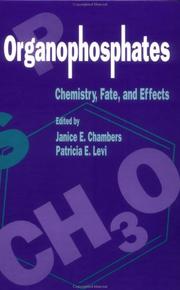| Listing 1 - 10 of 13 | << page >> |
Sort by
|
Book
ISBN: 008006633X Year: 1970 Publisher: Oxford Pergamon
Abstract | Keywords | Export | Availability | Bookmark
 Loading...
Loading...Choose an application
- Reference Manager
- EndNote
- RefWorks (Direct export to RefWorks)

ISBN: 0121673456 1322267065 0080917267 Year: 1992 Publisher: London : Academic Press,
Abstract | Keywords | Export | Availability | Bookmark
 Loading...
Loading...Choose an application
- Reference Manager
- EndNote
- RefWorks (Direct export to RefWorks)
Organophosphorus compounds --- Toxicology --- Insecticides --- Organophosphorus compounds - Toxicology. --- Insecticides - Toxicology. --- TOXICOLOGY --- Cholinesterase inhibitors --- INSECTICIDES --- Monograph --- Toxicology. --- Insecticides. --- Pesticides --- Anticholinesterase agents --- Enzyme inhibitors --- Parasympathomimetic agents --- Phosphoorganic compounds --- Phosphorus organic compounds --- Organic compounds --- Phosphorus compounds --- Chemicals --- Medicine --- Pharmacology --- Poisoning --- Poisons

ISBN: 0817638792 1461286603 1461241162 3764338792 Year: 1997 Publisher: Boston, Mass. Birkhäuser
Abstract | Keywords | Export | Availability | Bookmark
 Loading...
Loading...Choose an application
- Reference Manager
- EndNote
- RefWorks (Direct export to RefWorks)
Geriatrics --- Geriatric nursing --- Neuropathology --- Alzheimer's Disease --- Alzheimer's disease --- Cholinesterase inhibitors --- Therapy. --- Chemotherapy. --- Molecular aspects. --- Treatment. --- Therapeutic use. --- Neurology . --- Life sciences. --- Medicine. --- Neurology. --- Life Sciences, general. --- Biomedicine, general. --- Health Workforce --- Biosciences --- Sciences, Life --- Science --- Medicine --- Nervous system --- Neuropsychiatry --- Diseases --- Alzheimer disease --- Alzheimer's dementia --- Basal ganglia --- Presenile dementia --- Senile dementia --- Anticholinesterase agents --- Enzyme inhibitors --- Parasympathomimetic agents

ISBN: 9780126480825 0126480826 0080454356 9780080454351 1280630787 9781280630781 9780080543109 0080543103 0128041013 9786610630783 9780120885237 0120885239 9786611036959 1281036951 Year: 2006 Publisher: Amsterdam ; Boston : Elsevier Academic Press,
Abstract | Keywords | Export | Availability | Bookmark
 Loading...
Loading...Choose an application
- Reference Manager
- EndNote
- RefWorks (Direct export to RefWorks)
This text/reference book provides the most comprehensive coverage of anticholinesterase compounds (Organophosphates and Carbamates), which constitute the largest number of chemicals that are primarily used as insecticides in agriculture, industry, and around the home/garden. Some OPs (nerve agents) have been used in chemical warfare and terrorist attacks, while some OPs and CMs have been recommended as therapeutic agents in human medicine as well as in veterinary medicine. Many chemicals of both classes are extremely toxic and lack selectivity, thus their inadvertent/accidental use continues t
Orthopaedics. Traumatology. Plastic surgery --- Nervous system --- Neuropharmacology --- Clinical trials --- Controlled clinical trials --- Patient trials of new treatments --- Randomized clinical trials --- Trials, Clinical --- Clinical medicine --- Human experimentation in medicine --- Neurotropic drugs --- Neurosciences --- Pharmacology --- Diseases --- Research --- Drug effects --- Effect of drugs on --- Organophosphorus compounds --- Carbamates --- Cholinesterase inhibitors --- Pesticides --- Insecticides --- Wildlife, Effect of insecticides on --- Anticholinesterase agents --- Enzyme inhibitors --- Parasympathomimetic agents --- Carbamic acid --- Toxicology. --- toxicity --- poisoning

Abstract | Keywords | Export | Availability | Bookmark
 Loading...
Loading...Choose an application
- Reference Manager
- EndNote
- RefWorks (Direct export to RefWorks)
Hygiene. Public health. Protection --- Military engineering --- Chemical warfare --- Organophosphorus compounds --- Guerre chimique --- Composés organophosphorés --- Cholinesterase inhibitors --- Antidotes --- Safety measures --- Congresses --- Toxicology --- 800 Collectie Vlaams Vredesinstituut --- 810 Theorie en Methode --- 813 Methodologie --- 844.5 Gezondheid --- 872 Massavernietigingswapens --- Composés organophosphorés --- Phosphoorganic compounds --- Phosphorus organic compounds --- Organic compounds --- Phosphorus compounds --- Anticholinesterase agents --- Enzyme inhibitors --- Parasympathomimetic agents --- CBR warfare --- Chemistry in warfare --- Air warfare --- War --- Antipoisonous agents --- Poisons --- Safety measures&delete& --- Toxicology&delete& --- Chemical warfare - Safety measures - Congresses --- Organophosphorus compounds - Toxicology - Congresses --- Cholinesterase inhibitors - Toxicology - Congresses --- Antidotes - Congresses
Book
Year: 2021 Publisher: Basel, Switzerland MDPI - Multidisciplinary Digital Publishing Institute
Abstract | Keywords | Export | Availability | Bookmark
 Loading...
Loading...Choose an application
- Reference Manager
- EndNote
- RefWorks (Direct export to RefWorks)
Epidemiological evidence from the last fifty years has demonstrated that nutrition plays a decisive role in human health. Eating properly is not only necessary to meet energy demands. It also actively contributes, through both preventive actions and therapeutic effects, to improving human wellness. Nutrition owes its functional role in human health to the biological activity of specific, small dietary molecules. Plants are the most important source of bioactive molecules, and dietary phytochemicals are mainly responsible for the documented protective effects of diets which are rich in plant foods. Dietary phytochemicals have attracted increasing interest in human nutrition research over the past few years due to their ability to exert several biological effects that are potentially useful for human health, In this Special Issue, the biological activity of dietary phytochemicals, either purified or in extracts from plant foods, and their potential effects on human health are addressed and investigated.
resveratrol --- bioactivities --- anticancer --- anti-obesity --- antidiabetes --- molecular mechanisms --- durum wheat bread --- Portulaca oleracea L. --- essential fatty acids --- omega-6/omega-3 ratio --- antioxidants --- Bangladesh --- vegetables --- polyphenols --- amylase --- glucosidase --- renin --- angiotensin-converting enzyme --- lipase --- mass spectrometry --- yeast --- antioxidant --- cytotoxicity --- bioavailability --- viability --- Punica granatum --- hydrolysable tannins --- flavonoids --- Ultra High Performance Liquid Chromatography-Orbitrap-Mass Spectrometry --- tempura --- deep-fried product --- barley --- buckwheat --- Job’s tears --- antioxidant capacity --- oil deterioration --- polyphenol --- oxidative stress --- necroptosis --- plant extract --- secondary metabolite --- γH2AX --- copper --- African food spices --- GC-MS (gas chromatography mass spectrometry) --- antimicrobial --- antibiofilm --- violacein inhibition --- swarming inhibition --- swimming inhibition --- anticholinesterase --- antiurease --- antityrosinase --- sensory analysis --- mineral content --- proanthocyanidins --- carotenoids --- antioxidant activity --- FRAP --- DPPH --- ABTS --- CAA --- n/a --- Job's tears
Book
Year: 2021 Publisher: Basel, Switzerland MDPI - Multidisciplinary Digital Publishing Institute
Abstract | Keywords | Export | Availability | Bookmark
 Loading...
Loading...Choose an application
- Reference Manager
- EndNote
- RefWorks (Direct export to RefWorks)
Epidemiological evidence from the last fifty years has demonstrated that nutrition plays a decisive role in human health. Eating properly is not only necessary to meet energy demands. It also actively contributes, through both preventive actions and therapeutic effects, to improving human wellness. Nutrition owes its functional role in human health to the biological activity of specific, small dietary molecules. Plants are the most important source of bioactive molecules, and dietary phytochemicals are mainly responsible for the documented protective effects of diets which are rich in plant foods. Dietary phytochemicals have attracted increasing interest in human nutrition research over the past few years due to their ability to exert several biological effects that are potentially useful for human health, In this Special Issue, the biological activity of dietary phytochemicals, either purified or in extracts from plant foods, and their potential effects on human health are addressed and investigated.
Research & information: general --- resveratrol --- bioactivities --- anticancer --- anti-obesity --- antidiabetes --- molecular mechanisms --- durum wheat bread --- Portulaca oleracea L. --- essential fatty acids --- omega-6/omega-3 ratio --- antioxidants --- Bangladesh --- vegetables --- polyphenols --- amylase --- glucosidase --- renin --- angiotensin-converting enzyme --- lipase --- mass spectrometry --- yeast --- antioxidant --- cytotoxicity --- bioavailability --- viability --- Punica granatum --- hydrolysable tannins --- flavonoids --- Ultra High Performance Liquid Chromatography-Orbitrap-Mass Spectrometry --- tempura --- deep-fried product --- barley --- buckwheat --- Job's tears --- antioxidant capacity --- oil deterioration --- polyphenol --- oxidative stress --- necroptosis --- plant extract --- secondary metabolite --- γH2AX --- copper --- African food spices --- GC-MS (gas chromatography mass spectrometry) --- antimicrobial --- antibiofilm --- violacein inhibition --- swarming inhibition --- swimming inhibition --- anticholinesterase --- antiurease --- antityrosinase --- sensory analysis --- mineral content --- proanthocyanidins --- carotenoids --- antioxidant activity --- FRAP --- DPPH --- ABTS --- CAA --- resveratrol --- bioactivities --- anticancer --- anti-obesity --- antidiabetes --- molecular mechanisms --- durum wheat bread --- Portulaca oleracea L. --- essential fatty acids --- omega-6/omega-3 ratio --- antioxidants --- Bangladesh --- vegetables --- polyphenols --- amylase --- glucosidase --- renin --- angiotensin-converting enzyme --- lipase --- mass spectrometry --- yeast --- antioxidant --- cytotoxicity --- bioavailability --- viability --- Punica granatum --- hydrolysable tannins --- flavonoids --- Ultra High Performance Liquid Chromatography-Orbitrap-Mass Spectrometry --- tempura --- deep-fried product --- barley --- buckwheat --- Job's tears --- antioxidant capacity --- oil deterioration --- polyphenol --- oxidative stress --- necroptosis --- plant extract --- secondary metabolite --- γH2AX --- copper --- African food spices --- GC-MS (gas chromatography mass spectrometry) --- antimicrobial --- antibiofilm --- violacein inhibition --- swarming inhibition --- swimming inhibition --- anticholinesterase --- antiurease --- antityrosinase --- sensory analysis --- mineral content --- proanthocyanidins --- carotenoids --- antioxidant activity --- FRAP --- DPPH --- ABTS --- CAA
Book
Year: 2020 Publisher: Basel, Switzerland MDPI - Multidisciplinary Digital Publishing Institute
Abstract | Keywords | Export | Availability | Bookmark
 Loading...
Loading...Choose an application
- Reference Manager
- EndNote
- RefWorks (Direct export to RefWorks)
Nature represents an amazing source of inspiration, since it produces a great diversity of natural compounds selected by evolution, which exhibit multiple biological activities and applications. A large and very active research field is dedicated to identifying biosynthesized compounds, to improve/develop new methodologies, to produce/reuse natural compounds, and to assess their potential for pharmaceutical, cosmetic and food industries, among others, and additionally, to understand their mechanism of action. This book is dedicated to presenting the most recent results on the development of natural compounds’ applications. Ten original research works, organized by applications, and two reviews are included. Each of them contributes to the knowledge advance, insofar as they present new applications for known products, new methodologies to obtain new products, or the evaluation of a given application, with the applications related to health promotion being the most frequently considered. These works are significant contributions and reinforce the dynamic field of natural products’ applications.
Medicine --- amino acid metabolism --- carvacrol --- metabolomics data --- oxidative stress --- Penicillium digitatum --- Prangos pabularia Lindl. --- volatile oil --- PTP-1B --- osthole --- 5-pentylcyclohexa-1,3-diene --- antidiabetic activity --- chalcones --- aldol condensation --- biological activity --- flavanones --- cytotoxic --- antioxidant --- anticholinesterase --- Maytenus --- celastroloids --- semisynthesis --- antibacterial activity --- structure–activity relationship --- rosemary --- rosmarinic acid --- anticancer --- antidiabetic --- cardioprotective --- Helianthus annuus --- Helianthus strumosus --- Aspergillus niger --- Candida albicans --- Cryptococcus neoformans --- α-pinene --- oleracone --- flavonoid --- anti-aging --- longevity --- Portulaca oleracea L. --- Caenorhabditis elegans --- total synthesis --- pimenta d’água --- Candida --- fungistatic effect --- inhibition of dimorphism --- GC/MS --- colorectal cancer --- Salviae miltiorrhizae radix --- apoptosis --- honey --- propolis --- phenolic compounds --- wound-healing activity --- NHDF cells --- Asteraceae --- sesquiterpene lactones --- alantolactone --- arglabin --- parthenolide --- thapsigargin --- in vivo study --- anti-inflammatory --- almond --- byproducts --- chlorogenic acid --- design of experiment --- phenolic acids --- ultrasound-assisted extraction --- natural compounds --- therapeutic applications --- essential oils --- antimicrobial --- antitumor --- SAR
Book
Year: 2022 Publisher: Basel MDPI - Multidisciplinary Digital Publishing Institute
Abstract | Keywords | Export | Availability | Bookmark
 Loading...
Loading...Choose an application
- Reference Manager
- EndNote
- RefWorks (Direct export to RefWorks)
Plant essential oils (PEOs) are hydrophobic liquids that contain volatile chemical components that are derived from various plant parts. They are among the most important plant natural products because of their diverse biological features as well as their therapeutic and nutritional applications. In addition, several aromatic PEOs are used to flavor food and add aromas to incense in the culinary sector. Recently, many PEOs have demonstrated promising antimicrobial activity against different post-harvest diseases and have been considered as possible natural alternatives for chemical treatments. This Special Issue titled “Plant Essential Oil with Biological Activity” provided an overview of several elements of PEOs, including their biological applications, antimicrobial activities, bio-pharmaceutical properties, principal single constituents, and mechanisms of action. This Special Issues fills in knowledge gaps and aids in the advancement of EO applications around the world. This issue contains thirteen research articles and two review papers that address a wide range of topics and applications relevant to the bioactivity of PEOs.
Medicine --- Pharmacology --- allelopathy --- bioherbicides --- volatile oils --- terpenes --- aromatic plants --- Curcuma longa --- essential oil --- extraction methods --- chemical composition --- agri-food industry --- antimicrobial --- herbicidal --- antioxidant --- horseweed --- wavy-leaf fleabane --- sesquiterpenes --- cytotoxicity --- anti-senility --- tomato --- eco-friendly product --- essential oils --- quality preservation --- antioxidants --- damage index --- phytotoxicity --- environmental factors --- Cleome genus --- anti-inflammation --- Oncosiphon suffruticosum --- antibacterial --- tyrosinase inhibition --- sun protection factor --- medicinal plants --- GC-MS --- postharvest diseases --- biological control --- cell membrane permeability --- pale smartweed --- green chemistry --- herbicides --- Jungia rugosa --- Jungia bullata --- Jungia jelskii --- Jungia malvifolia --- Asteraceae --- enantiomers --- Ecuador --- Pulicaria crispa --- chemometric analysis --- chemotype --- Aerva javanica --- sandy soil --- hydrodistillation --- antioxidant activity --- seasonal variation --- angustione --- trichomes --- fruit storage --- natural products --- quality-related attributes --- volatiles --- Anisosciadium lanatum --- HepG2 --- BCL-2 --- CASPASE-3 --- apoptotic markers --- WRKY transcription factor --- Fusarium root rot --- Mentha spicata --- Mentha longifolia GC–MS --- antioxidant enzymes --- antifungal activity --- Annona cherimola --- enantioselective analysis --- antibacterial activity --- anticholinesterase activity --- germacrene D --- Campylobacter jejuni --- antimicrobial activity --- phytopathogens --- food preservatives
Book
Year: 2022 Publisher: Basel MDPI - Multidisciplinary Digital Publishing Institute
Abstract | Keywords | Export | Availability | Bookmark
 Loading...
Loading...Choose an application
- Reference Manager
- EndNote
- RefWorks (Direct export to RefWorks)
Plant essential oils (PEOs) are hydrophobic liquids that contain volatile chemical components that are derived from various plant parts. They are among the most important plant natural products because of their diverse biological features as well as their therapeutic and nutritional applications. In addition, several aromatic PEOs are used to flavor food and add aromas to incense in the culinary sector. Recently, many PEOs have demonstrated promising antimicrobial activity against different post-harvest diseases and have been considered as possible natural alternatives for chemical treatments. This Special Issue titled “Plant Essential Oil with Biological Activity” provided an overview of several elements of PEOs, including their biological applications, antimicrobial activities, bio-pharmaceutical properties, principal single constituents, and mechanisms of action. This Special Issues fills in knowledge gaps and aids in the advancement of EO applications around the world. This issue contains thirteen research articles and two review papers that address a wide range of topics and applications relevant to the bioactivity of PEOs.
allelopathy --- bioherbicides --- volatile oils --- terpenes --- aromatic plants --- Curcuma longa --- essential oil --- extraction methods --- chemical composition --- agri-food industry --- antimicrobial --- herbicidal --- antioxidant --- horseweed --- wavy-leaf fleabane --- sesquiterpenes --- cytotoxicity --- anti-senility --- tomato --- eco-friendly product --- essential oils --- quality preservation --- antioxidants --- damage index --- phytotoxicity --- environmental factors --- Cleome genus --- anti-inflammation --- Oncosiphon suffruticosum --- antibacterial --- tyrosinase inhibition --- sun protection factor --- medicinal plants --- GC-MS --- postharvest diseases --- biological control --- cell membrane permeability --- pale smartweed --- green chemistry --- herbicides --- Jungia rugosa --- Jungia bullata --- Jungia jelskii --- Jungia malvifolia --- Asteraceae --- enantiomers --- Ecuador --- Pulicaria crispa --- chemometric analysis --- chemotype --- Aerva javanica --- sandy soil --- hydrodistillation --- antioxidant activity --- seasonal variation --- angustione --- trichomes --- fruit storage --- natural products --- quality-related attributes --- volatiles --- Anisosciadium lanatum --- HepG2 --- BCL-2 --- CASPASE-3 --- apoptotic markers --- WRKY transcription factor --- Fusarium root rot --- Mentha spicata --- Mentha longifolia GC–MS --- antioxidant enzymes --- antifungal activity --- Annona cherimola --- enantioselective analysis --- antibacterial activity --- anticholinesterase activity --- germacrene D --- Campylobacter jejuni --- antimicrobial activity --- phytopathogens --- food preservatives
| Listing 1 - 10 of 13 | << page >> |
Sort by
|

 Search
Search Feedback
Feedback About
About Help
Help News
News